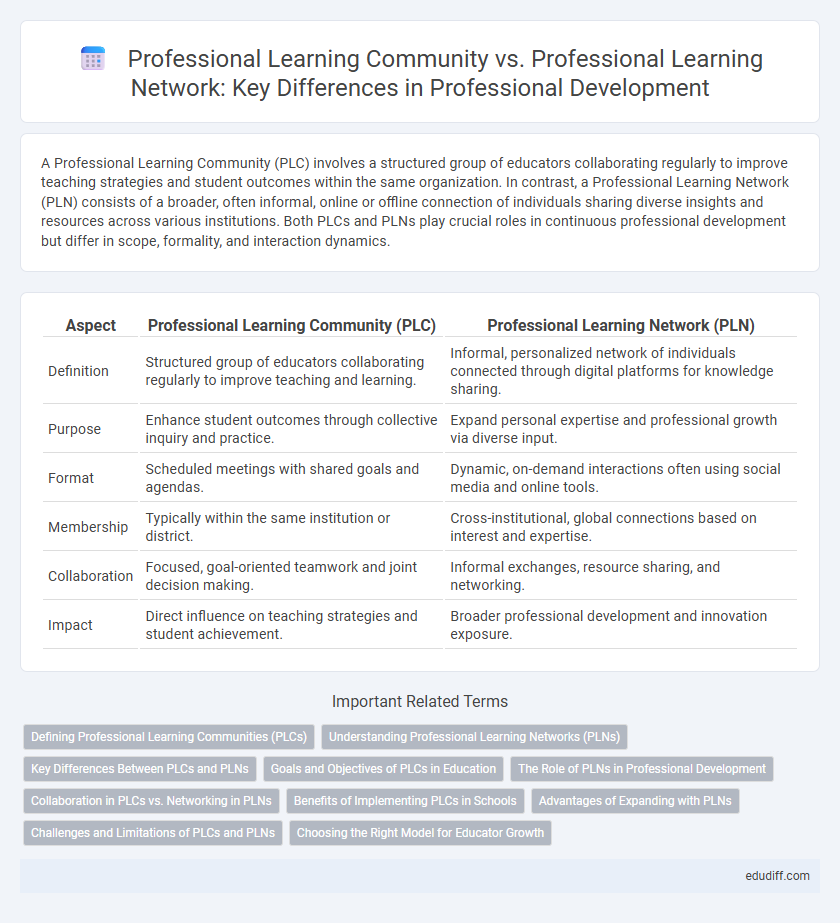A Professional Learning Community (PLC) involves a structured group of educators collaborating regularly to improve teaching strategies and student outcomes within the same organization. In contrast, a Professional Learning Network (PLN) consists of a broader, often informal, online or offline connection of individuals sharing diverse insights and resources across various institutions. Both PLCs and PLNs play crucial roles in continuous professional development but differ in scope, formality, and interaction dynamics.
Table of Comparison
| Aspect | Professional Learning Community (PLC) | Professional Learning Network (PLN) |
|---|---|---|
| Definition | Structured group of educators collaborating regularly to improve teaching and learning. | Informal, personalized network of individuals connected through digital platforms for knowledge sharing. |
| Purpose | Enhance student outcomes through collective inquiry and practice. | Expand personal expertise and professional growth via diverse input. |
| Format | Scheduled meetings with shared goals and agendas. | Dynamic, on-demand interactions often using social media and online tools. |
| Membership | Typically within the same institution or district. | Cross-institutional, global connections based on interest and expertise. |
| Collaboration | Focused, goal-oriented teamwork and joint decision making. | Informal exchanges, resource sharing, and networking. |
| Impact | Direct influence on teaching strategies and student achievement. | Broader professional development and innovation exposure. |
Defining Professional Learning Communities (PLCs)
Professional Learning Communities (PLCs) are structured groups of educators who collaborate regularly to improve teaching practices and student outcomes through shared goals, data analysis, and reflective dialogue. PLCs emphasize collective responsibility and ongoing professional development within a specific school or district environment. Unlike broader Professional Learning Networks, PLCs operate with formal protocols and a strong focus on continuous improvement in a defined organizational context.
Understanding Professional Learning Networks (PLNs)
Professional Learning Networks (PLNs) consist of diverse connections among educators and experts, facilitating personalized and ongoing knowledge exchange beyond traditional settings. Unlike Professional Learning Communities (PLCs), which are often school-based and structured, PLNs leverage digital platforms enabling real-time collaboration, resource sharing, and global communication. Understanding PLNs involves recognizing their role in fostering continuous professional growth through flexible, networked learning and peer support.
Key Differences Between PLCs and PLNs
Professional Learning Communities (PLCs) are structured groups within organizations that focus on collaborative learning and improving teaching practices through regular meetings and shared goals, whereas Professional Learning Networks (PLNs) are flexible, often virtual, connections of individuals centered on knowledge exchange and personal professional growth. PLCs emphasize collective responsibility and data-driven decision-making to enhance educational outcomes, while PLNs prioritize diverse resource access and networking across broader communities. The key difference lies in PLCs' formal collaboration within a specific setting versus PLNs' informal, expansive nature driven by individual initiative.
Goals and Objectives of PLCs in Education
Professional Learning Communities (PLCs) in education prioritize collaborative, ongoing teacher development aimed at improving student outcomes through shared goals and data-driven instruction. Their objectives focus on fostering continuous learning, collective responsibility, and reflective practice among educators within a specific school or district. Unlike Professional Learning Networks, which emphasize broad, often virtual connections, PLCs concentrate on structured teamwork and alignment with institutional goals.
The Role of PLNs in Professional Development
Professional Learning Networks (PLNs) play a crucial role in professional development by enabling educators to connect globally, share diverse resources, and engage in continuous collaborative learning beyond traditional organizational boundaries. Unlike Professional Learning Communities (PLCs), which operate within a defined group or school, PLNs utilize digital platforms and social media to facilitate real-time feedback, personalized learning paths, and access to a wide array of expertise. This dynamic and expansive interaction fosters innovation, reflective practice, and adaptability essential for sustained professional growth in rapidly evolving educational environments.
Collaboration in PLCs vs. Networking in PLNs
Professional Learning Communities (PLCs) emphasize collaboration through structured group interactions, shared goals, and collective problem-solving to enhance teaching practices and student outcomes. Professional Learning Networks (PLNs) prioritize networking by enabling educators to connect, share resources, and seek expertise across broader, often digital, platforms without the constraints of formal group membership. The collaborative nature of PLCs fosters deep, sustained engagement within a specific context, while PLNs offer flexible, diverse interactions that support personalized professional growth.
Benefits of Implementing PLCs in Schools
Implementing Professional Learning Communities (PLCs) in schools fosters collaborative teaching practices, enhancing student achievement through shared expertise and continuous improvement. PLCs promote a culture of accountability and data-driven decision-making, leading to tailored instructional strategies that meet diverse learner needs. Schools benefit from sustained professional growth and stronger collegial relationships, driving systemic change and improved educational outcomes.
Advantages of Expanding with PLNs
Expanding professional development through Professional Learning Networks (PLNs) offers access to diverse expertise across global industries, fostering innovative problem-solving and adaptability. PLNs enable real-time knowledge exchange and personalized learning paths, enhancing skill acquisition beyond the scope of traditional Professional Learning Communities (PLCs). Leveraging digital platforms, PLNs support continuous, scalable collaboration that drives career growth and organizational performance.
Challenges and Limitations of PLCs and PLNs
Professional Learning Communities (PLCs) often face challenges such as limited collaboration due to hierarchical structures and time constraints within organizations, which can inhibit sustained professional growth. Conversely, Professional Learning Networks (PLNs) may struggle with information overload and lack of personalized relevance, impacting the effectiveness of knowledge exchange. Both PLCs and PLNs require intentional design and management to overcome barriers related to engagement, trust-building, and resource accessibility for optimal professional development outcomes.
Choosing the Right Model for Educator Growth
Professional Learning Communities (PLCs) emphasize structured, collaborative team-based approaches within schools to drive educator development through shared goals and data-driven strategies. Professional Learning Networks (PLNs) offer expansive, personalized connectivity with diverse educators and experts beyond immediate institutions, fostering continuous, informal learning. Selecting the appropriate model depends on institutional objectives, desired collaboration depth, and educator preferences for localized interaction versus broad, flexible engagement.
Professional Learning Community vs Professional Learning Network Infographic

 edudiff.com
edudiff.com